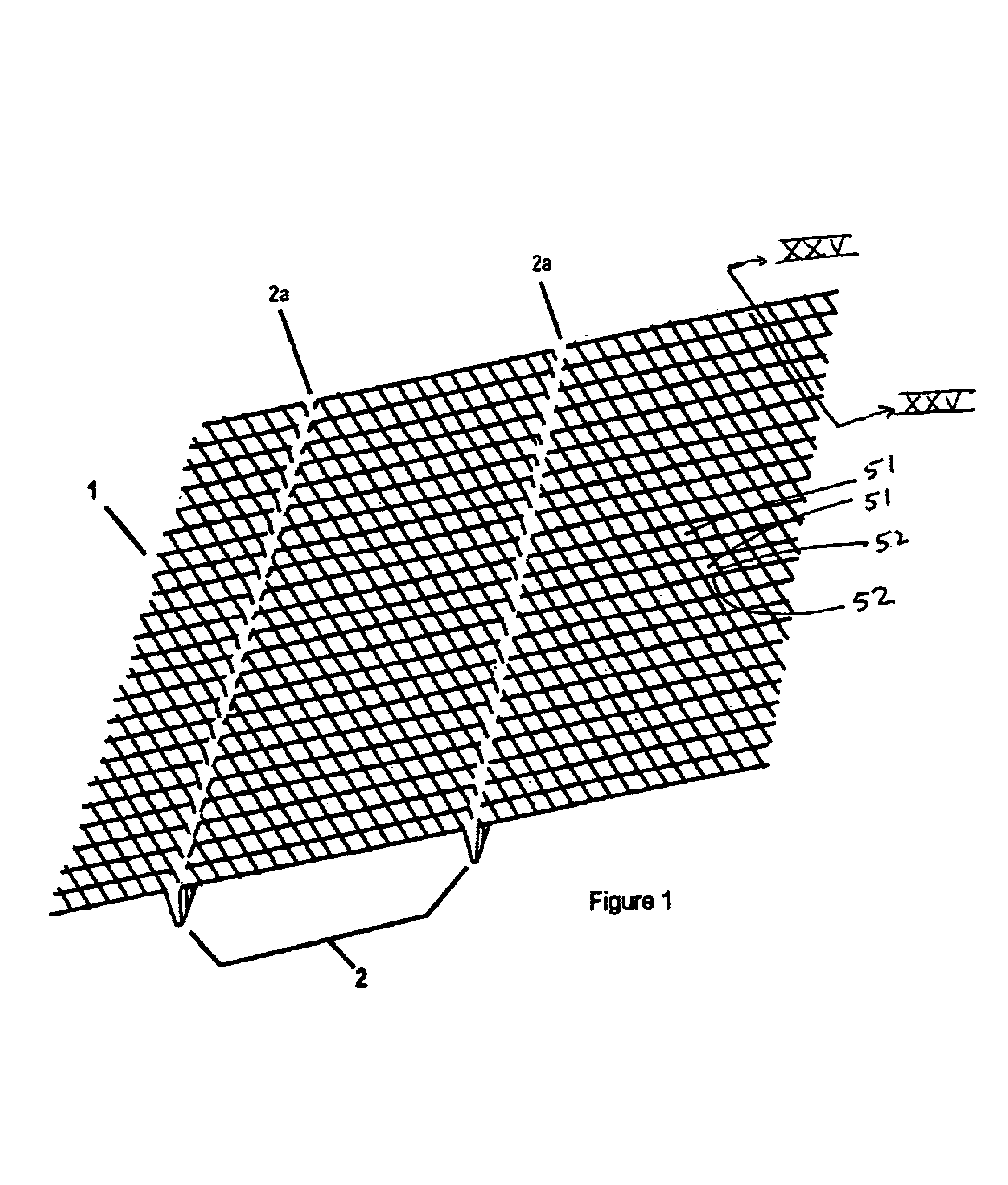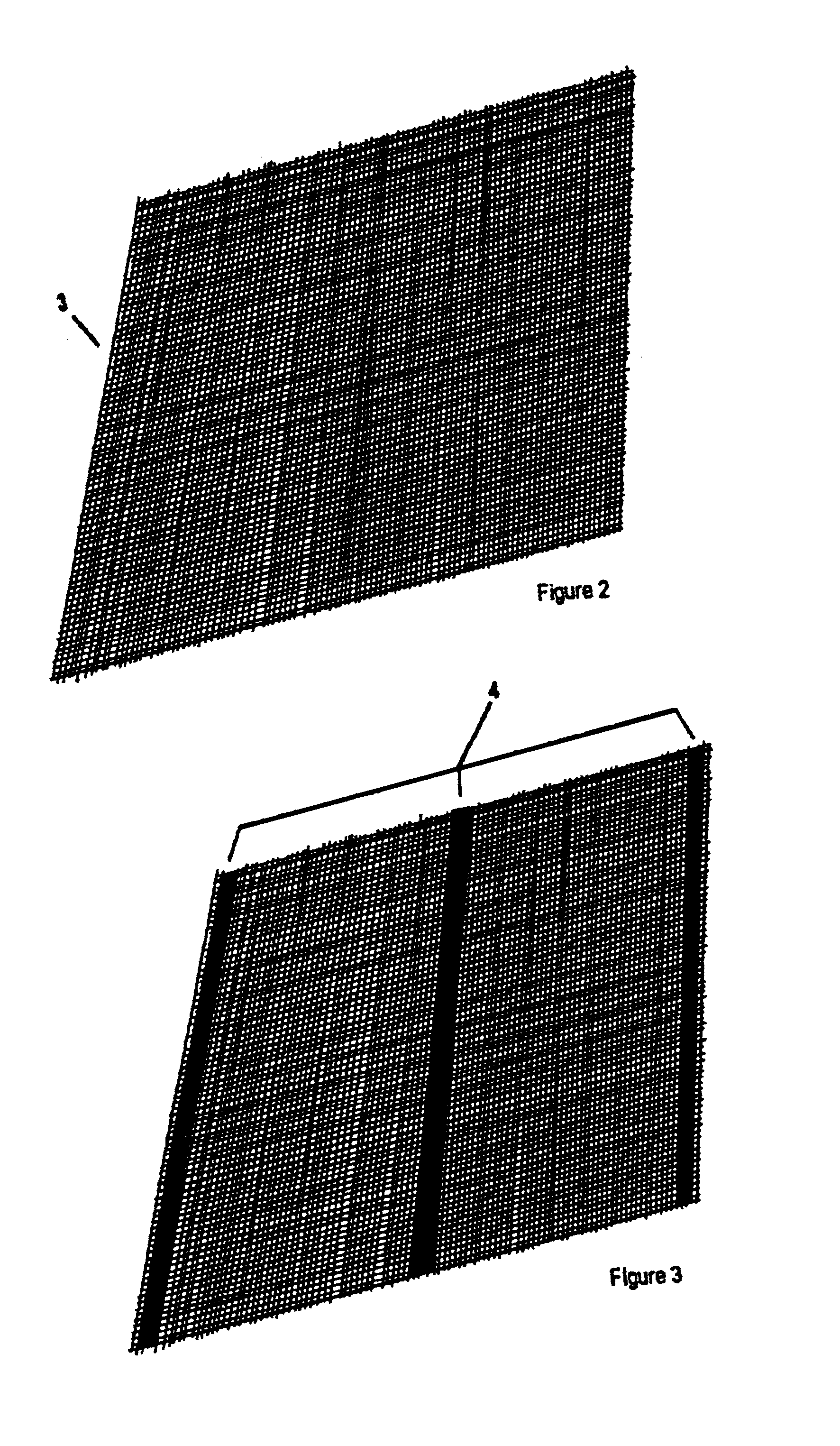The LEAFFILTER.RTM.
system, however, is costly to manufacture in comparison to other gutter guard systems.
This may cause permanent accumulation of debris upon the composite gutter guard and water-proofing may allow forward, rather than downward flow of water to occur.
In instances of high ambient temperatures sonic welded fiberglass has been shown to break free of the underlying
polymer plane and the composite gutter guard has been shown to warp and wave due to heat deformation.
As occurs with U.S. Pat. No. 6,146,020, copious amounts of
roof runoff may negate the intended effect of water returning to the gutter allowing for forward flow of water past the gutter.
In my U.S. Pat. No. 6,598,352 it is disclosed that such forward rather than downward flow of water has been shown to cease if downward extending planes or rods of varying heights, disallowing a linear channeling path for water to follow, and sufficiently spaced are employed beneath the top most surface of water receiving areas but the disclosed preferred embodiment has been shown costly to manufacture.
What may appear as a logical anticipation by such inventions at first glance, (inserting of a filter mesh or material into the channel), has been shown to be undesirable and ineffective across a
broad spectrum of filtering materials: Employing insertable filters into such inventions has not been found to be a simple matter of anticipation, or
design choice of filter medium by those skilled in the arts.
Rather, it has proved to be an ineffective option, with any known filter medium, when attempted in the field.
Such attempts, in the field, have demonstrated that the filter mediums will eventually require manual cleaning.
However, for the reasons described in the preceding paragraphs, an ability to attach a medium to an invention, not specifically designed to utilize such a medium, may not result in an effective anticipation by an invention.
Vail's invention does initially prevent some debris from entering an underlying rain gutter but gradually becomes ineffective at channeling water into a rain gutter due to the propensity of their claimed filter mediums to clog with debris.
Though Vail's invention embodies an insertable filter, such filter is not readily accessible for cleaning when such cleaning is necessitated.
The gutter cover must be removed and uplifted for cleaning and, the filter medium is not easily and readily inserted replaced into its longitudinal containing channel extending three or more feet.
It is often noted, in the field, that these and similar inventions hold fast pine needles in great numbers which presents an unsightly appearance as well as create debris dams behind the upwardly extended and trapped pine needles.
Such filter meshes and non-woven lofty
fiber mesh materials, even when composed of finer micro-porous materials, additionally tend to clog and fill with oak tassels and other smaller organic debris because they are not resting, by design, on a skeletal structure that encourages greater
water flow through its overlying filter membrane than exists when such filter meshes or membranes contact planar continuously-connected surfaces.
Known filter mediums of larger openings tend to trap and hold debris.
A simple
design choice or anticipation of multiplying the perforations can result in a weakened body subject to
deformity when exposed to the weight of
snow and / or debris or when, in the case of polymer bodies, exposed to summer temperatures and
sunlight.
However, during heavy rainfall,
roof runoff is known to simply travel over the top most surface of such a device past an underlying gutter rather that downward into the gutter.
He states that success with such devices has been limited because small debris and pine needles still may enter through them into a rain gutter and clog its
downspout opening and or lodge in and clog the devices themselves.
However, in practice it is known that such devices as is disclosed by Rees are only partially effective at shedding debris while channeling rainwater into an underlying gutter.
However, though Rees and Gentry did achieve finer
filtration over filter medium utilized in prior art, their inventions also exhibit a tendency to channel water past an underlying gutter and / or to heal over with finer
dirt,
pollen, and other pollutants and clog thereby requiring manual cleaning.
Additionally, when filter medium is applied to or rested upon planar perforated or screen meshed surfaces, there is a notable tendency for the underlying perforated plane or screen to channel water past the gutter where it will then spill to the ground.
Such sagging creates pockets wherein debris tends to settle and enmesh.
Though Dugan anticipates that any debris gathered on the upper barrier surface will dry and blow away, that is not always the case with this or similar devices.
In practice, such devices are known to “heal over” with
pollen, oil, and other pollutants and effectively waterproof or clog the device rendering it ineffective in that they prevent both debris and water from entering a rain gutter.
Pollen may actually
cement debris to the top surface of such devices and fail to allow wash-off even after repeated rains.
As with other prior art, such devices may work effectively for a period of time but tend to eventually channel water past a rain gutter, due to eventual clogging of the device itself.
However, as in other filtering attempts, shingle material and pine needles can become trapped in the coarse
nylon mesh and must be periodically cleaned.
Filtering mediums (exhibiting tightly woven, knitted, or tangled mesh threads to achieve density or “smoothness”) disclosed in Tregear and other prior art have been unable to achieve imperviousness to
waterproofing and clogging effects caused by a healing or pasting over of such surfaces by pollen, fine
dirt, scum, oils, and air and
water pollutants.
Prior art has employed filter cloths over underlying mesh, screens, cones, longitudinal rods, however such prior art has eventually been realized as unable to prevent an eventual clogging of their finer filtering membranes by pollen,
dirt, oak tassels, and finer debris.
Such prior art has been noted to succumb to eventual clogging by the healing over of debris which adheres itself to surfaces when intermingled with organic oils, oily pollen, and shingle oil that act as an
adhesive.
The hoped for cleaning of leaves, pine needles, seed pods and other debris by
water flow or wind, envisioned by Tregear and other prior art, is often not realized due to their adherence to surfaces by pollen, oils, pollutants, and silica dusts and water mists.
Additionally, multi-channeled embodiments of longitudinal reverse curve prior art have been noted to allow their water receiving channels to become packed with pine needles, oak tassels, other debris, and eventually clog disallowing the free passage of water into a rain gutter.
None of theses above-described systems keep all debris out of a gutter
system allowing water alone to enter, for an extended length of time.
Still others, particularly those employing filter membranes, succumb to a paste and or scum-like healing over and clogging of their
filtration-membranes over time rendering them unable to channel water into a rain gutter.
Of the remainder of the above described systems it has been noted that a buildup or
coating of debris, pollutants, and oils either cause water adhesion properties to be lost or
cause blockage of water receiving openings resulting in rain water roof run-off to flow past, rather than into, an underlying rain gutter.
 Login to View More
Login to View More 


